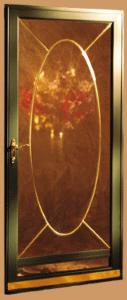Search engine visitors - click here to access entire "$ensible Home" web site
Click here to see a descriptive illustration of several designs of screen/storm doors
Dear Jim: I thought about installing a decorative storm/screen door in the front and a durable one in the back for ventilation, energy savings and for additional security. What types of doors do you recommend? - Stan T.

A: Installing combination storm/screen doors is a good idea for almost any home for all of the reasons you described. They also provide protection from harsh weather and direct sun for your primary doors. This will reduce maintenance and greatly increase the doors' lives.
The energy savings throughout the door's life can often payback the cost of installing a good-quality storm/screen door. During the winter, it creates an insulating dead air space around your door. During the summer, it will block some of the sun and allow for natural ventilation to lower air-conditioning costs.
Although all storm doors will satisfy your needs to some extent, various designs and models will satisfy them to various degrees. You will probably want different designs for front and back doors because of different needs.
A door with a lot of screen/glass (leaded, beveled, stained) area provides good ventilation and an attractive appearance for a front door. For a back door where security is more important, you should probably chose one with less glass, stronger frame and screen (also for pets) materials and better locks.
When you are shopping for a storm/screen door, don't just buy the cheapest model at your home center store. Even though many look similar, there are significant differences in quality. Frame and hardware design features and warranties (lifetime or as long as you own your house) are good indicators.
The primary materials used for the door frames are wood, aluminum skins, fiberglass, polypropylene, wrought iron, and steel. Wrought iron is probably the most secure (with deadbolts and heavy hinges) and decorative. It, as does steel, has a price tag several times higher than many other storm/screen doors.
An aluminum skin over a rigid core is a good compromise for many homes. The core material, whether foam insulation or particle board, does not have a major impact on the efficiency since glass comprises much of the door.
A triple-track door is one of the best designs, especially for a back door where ventilation is a concern. If you lower the top glass and raise the bottom glass panels a little, this creates a natural air current path to help ventilate your house. You never have to remove the screen or glass panels.
A self-storing door has less glass area so the glass panel can be slipped down and hidden inside the door. The more decorative models with full glass panels require the entire panel to be switched with a screen panel each spring.
Instant Download Update Bulletin No. 457 - buyer's guide of the nine best, most secure screen/storm doors listing styles available, construction type and materials used, core/insulation levels, standard colors and hardware (locks, handles, hinges, etc.) available, unique features including type of glass used, prices and illustrations of many styles, guide to measuring for a storm door.
Dear Jim: I have been considering replacing my old central air conditioner and I keep hearing the term "SEER." Please tell me exactly what this means and how will it impact how much it costs to keep my house cool? - Mike F.
A: SEER stands for Seasonal Energy Efficiency Ratio. It basically compares the amount of cooling produced to the amount of electricity used. A higher SEER is better because you get more cooling using less electricity.
Years ago, EER (Energy Efficiency Ratio) was used. The more recent SEER takes into account more factors including the inefficiencies each time the compressor starts and stops and is a more accurate representation of efficiency.